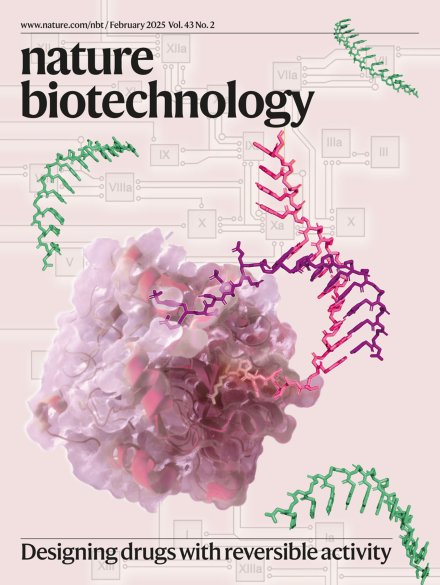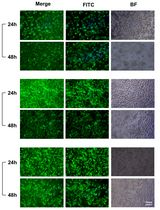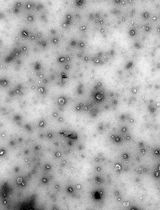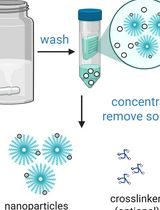- EN - English
- CN - 中文
Preparation and Characterization of Lipid Nanoparticles Co-loaded With DNA and Nitro-Oleic Acid
DNA 与硝基油酸共载脂质纳米颗粒的制备与表征
发布: 2025年09月20日第15卷第18期 DOI: 10.21769/BioProtoc.5450 浏览次数: 3001
评审: Andrea GramaticaAnonymous reviewer(s)
Abstract
Lipid nanoparticles (LNPs) are powerful carriers for nucleic acid delivery, but plasmid DNA-loaded LNPs (pDNA-LNPs) have been limited by inflammation and toxicity. We showed that standard pDNA-LNPs activate the cGAS–STING pathway, leading to severe immune responses and mortality in mice. To overcome this, we co-loaded nitro-oleic acid (NOA), an endogenous STING inhibitor, into pDNA-LNPs. NOA-pDNA-LNPs mitigated inflammation, enabled safe in vivo delivery, and supported sustained gene expression for months. Here, we present a detailed protocol for producing and characterizing NOA-pDNA-LNPs to facilitate safer, long-term gene delivery applications.
Key features
• Provides a step-by-step protocol to produce plasmid DNA–LNPs co-loaded with nitro-oleic acid (NOA), optimized for both in vitro and in vivo applications.
• Includes methods for quantitative assessment of DNA and NOA encapsulation efficiencies, particle size, and quality control metrics.
Keywords: Lipid nanoparticles (脂质纳米颗粒)Graphical overview
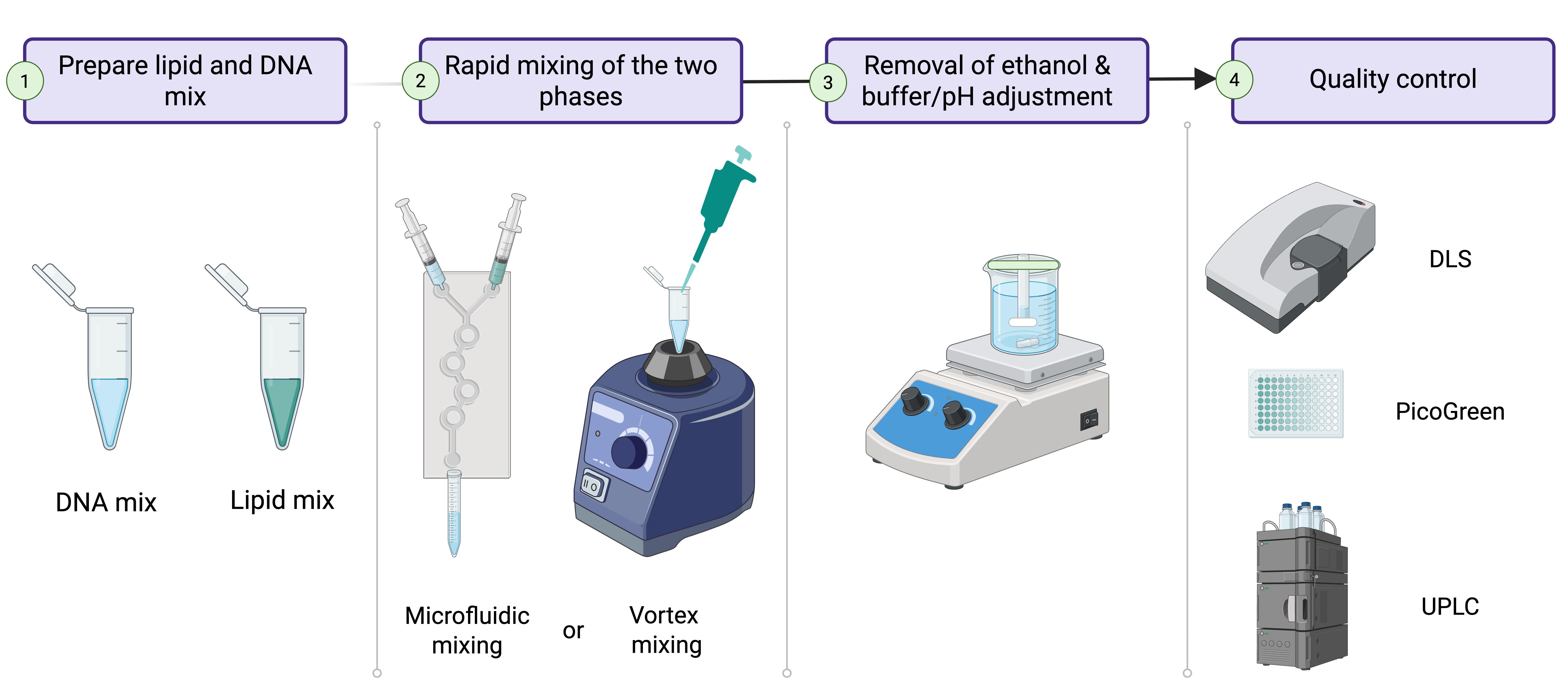
Lipid nanoparticle (LNP) production process. 1. Prepare lipid and DNA mixes in separate 2 mL Eppendorf tubes. 2. Mix the two phases using either a microfluidic chip or a vortex mixer. 3. Dialyze the formed LNPs against 1× PBS, pH 7.4, for 2 h to remove remaining ethanol and adjust pH. 4. Validate LNP quality before use or storage.
Background
The success of COVID-19 mRNA vaccines showcased the power of lipid nanoparticles (LNPs) to deliver nucleic acids and achieve high protein expression [1]. While most LNP applications focus on mRNA or siRNA, these cargos are short-lived and lack promoter control. In contrast, DNA offers longer-term expression (months to years), cell type–specific promoter regulation, and greater stability, making it ideal for expressing therapeutic proteins, gene editors, or shRNAs for long-term effects [2–4].
DNA-loaded LNPs combine durable expression with the advantages of LNPs: high delivery efficiency, low immunogenicity (compared to viral vectors), and flexible cargo capacity. However, their development has lagged due to safety concerns. We found that plasmid DNA-LNPs (pDNA-LNPs) trigger strong inflammation in naive mice, leading to 100% mortality at standard doses [5]. Using knockout mouse models and in vitro assays, we identified the cGAS–STING pathway as the main driver. This innate immune pathway detects cytosolic DNA and activates pro-inflammatory cytokines like type I interferons and IL-6.
To overcome this, we took inspiration from DNA viruses that evade STING-mediated immunity. We loaded pDNA-LNPs with nitro-oleic acid (NOA), an endogenous STING inhibitor. These NOA-pDNA-LNPs eliminated inflammation in vitro and prevented mortality in vivo, without compromising transgene expression.
Together, these results demonstrate that pDNA-LNPs co-loaded with bioactive lipids like NOA can enable safe, long-term gene expression. Here, we present a detailed protocol for producing NOA-pDNA-LNPs to support a broader application of this promising gene delivery platform.
Materials and reagents
Reagents
1. SM-102 (Echelon Biosciences, catalog number: N-1020); store at -20 °C
2. Cholesterol (Avanti Polar Lipids, catalog number: 700100P); store at -20 °C
3. 1,2-distearoyl-sn-glycero-3-phosphocholine (DSPC) (Avanti Polar Lipids, catalog number: 850365); store at -20 °C
4. 1,2-dimyristoyl-rac-glycero-3-methoxypolyethylene glycol-2000 (DMG-PEG 2000) (Avanti Polar Lipids, catalog number: 880151); store at -20 °C
5. Nitro-oleic acid (NOA) (Echelon Biosciences, catalog number: L-0112); store at -20 °C
6. pALD-CV77-Luciferase (pDNA) (Aldevron, catalog number: 5078-5); store at 4 °C short-term and at -20 °C long-term
7. 200 proof ethanol (100% ethanol) (Millipore Sigma, catalog number: 459836-100ML); store at room temperature
8. DEPC water (Invitrogen, catalog number: AM9916); store at 4 °C
9. Phosphate-buffered saline (1× PBS), filter-sterilized (Thermo Fisher Scientific, catalog number: J61196.AP)
10. Acetonitrile (HPLC grade) (Fisher Scientific, catalog number: A998SK-1)
11. Trifluoroacetic acid (TFA) (Millipore Sigma, catalog number: 8082600026)
12. Quant-iT PicoGreen dsDNA assay (Invitrogen, catalog number: P11496); store at 4 °C short-term and at -20 °C long-term
13. Sodium citrate dihydrate (Millipore Sigma, catalog number: W302600)
14. Citric acid (Millipore Sigma, catalog number: 251275)
15. TE buffer (Thermo Fisher Scientific, catalog number: 12090015)
Laboratory supplies
1. 2 mL Eppendorf tubes (Fisher Scientific, catalog number: 05-402-7)
2. 15 mL conical Tubes (Thermo Fisher Scientific, catalog number: 339650)
3. 1–300 μL pipette tips (Fisher Scientific, SureOneTM Micropoint Pipette Tips, catalog number: 02-707-410)
4. 500 mL beaker (Corning, catalog number: 1000J-500)
5. Dialysis tubing 12–14 kD (Repligen, catalog number: 132697)
6. Dialysis tubing 55 mm and 35 mm closures (Repligen, catalog numbers: 132734 and 132760, respectively)
7. Disposable cuvettes (GMBH + Co KG, catalog number: 759075D)
8. Zeba columns (Thermo Fisher Scientific, catalog number: 89877)
9. UPLC vials (Thermo Fisher Scientific, catalog number: 6ESV9-04PP)
Equipment
1. P20 pipette (Gilson, catalog number: F144056M)
2. P200 pipette (Gilson, catalog number: F144058M)
3. Ultrasonic bath (Branson, catalog number: BRANCPX-952-538R)
4. NanoAssemblrTM IgniteTM instrument (Cytiva, catalog number: NIN0001)
5. NanoAssemblrTM IgniteTM cartridges (Cytiva, catalog number: NIN0061)
6. Vortex-Genie 2 (Fisher Scientific, catalog number: 50-728-002)
7. Zetasizer Pro ZS (Malvern Panalytical)
8. MiniMag Magnetic Stirrer (NETA/Sigma-Aldrich, catalog number: Z742293)
9. Acquity I-Class UPLC system (Waters)
10. Cortecs C18 column (1.6 μm particle size, 2.1 × 50 mm)
Procedure
文章信息
稿件历史记录
提交日期: Jul 15, 2025
接收日期: Aug 20, 2025
在线发布日期: Sep 1, 2025
出版日期: Sep 20, 2025
版权信息
© 2025 The Author(s); This is an open access article under the CC BY-NC license (https://creativecommons.org/licenses/by-nc/4.0/).
如何引用
Patel, M. N., Tiwari, S. and Brenner, J. S. (2025). Preparation and Characterization of Lipid Nanoparticles Co-loaded With DNA and Nitro-Oleic Acid. Bio-protocol 15(18): e5450. DOI: 10.21769/BioProtoc.5450.
分类
生物工程 > 生物医学工程 > 药物递送
分子生物学 > 纳米颗粒 > 植物源纳米颗粒
您对这篇实验方法有问题吗?
在此处发布您的问题,我们将邀请本文作者来回答。同时,我们会将您的问题发布到Bio-protocol Exchange,以便寻求社区成员的帮助。
Share
Bluesky
X
Copy link


